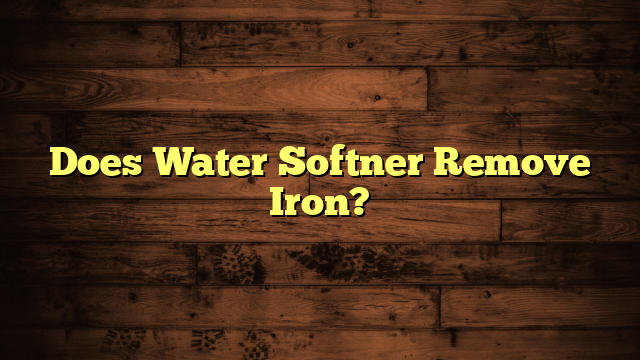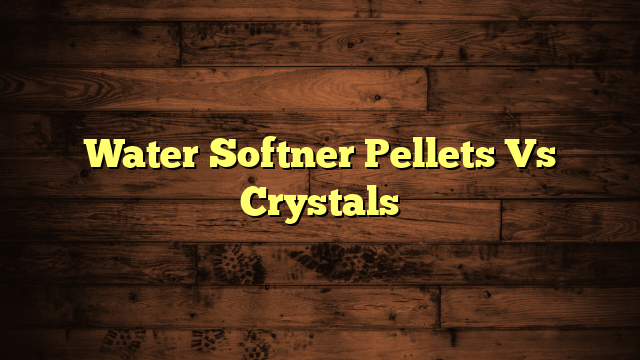Does Water Softner Remove Iron?
When you consider installing a water softener, you might wonder whether it can effectively tackle iron in your water supply. While these systems are designed to combat hardness, their ability to remove iron can vary considerably depending on the type of iron present. For instance, you might find that dissolved ferrous iron is manageable, but what about the rust-colored particles of ferric iron? Understanding these distinctions could be essential for your water quality, and there are other factors at play that you'll want to explore further.
Key Takeaways
- Water softeners can effectively remove low levels of ferrous iron, which remains dissolved in water.
- Ferric iron, which appears as rust-colored particles, may clog softener resin beads and hinder performance.
- Softeners are not designed for high iron removal; specialized filtration systems are recommended for significant iron issues.
- Regular testing of water chemistry is crucial to determine the appropriate treatment solution for iron removal.
- Alternative methods, such as iron filtration systems and chemical oxidation, are more effective for addressing elevated iron levels.
Understanding Water Softeners
When it comes to improving your water quality, understanding water softeners is vital. A water softener is designed to reduce hardness in your water, which can cause various problems, like scale buildup on appliances and plumbing fixtures.
By using a process called ion exchange, these systems replace calcium and magnesium ions with sodium ions, resulting in softer water.
To guarantee your water softener operates effectively, softener maintenance is important. Regularly checking the salt levels in your brine tank is one of the simplest yet most significant tasks.
If the salt runs low, the system can't regenerate properly, and you'll end up with hard water. Furthermore, you should clean the resin bed and inspect the bypass valve periodically to prevent any blockages or malfunctions.
It's also beneficial to keep an eye on the system's performance, noting any changes in water quality. If you notice signs of hard water, like soap scum or dull laundry, it might be time for a service check.
Types of Iron in Water
When it comes to iron in water, understanding the different types is essential for effective treatment.
Ferrous iron, often found in groundwater, remains dissolved until exposed to oxygen, while ferric iron is oxidized and visible as rust-colored particles.
Recognizing these characteristics helps you choose the right system for iron removal, ensuring cleaner water for your home.
Ferrous Iron Characteristics
Understanding ferrous iron characteristics is essential for effectively managing water quality. Ferrous iron, which is the soluble form of iron, typically exists in groundwater and can affect both your plumbing and the overall taste of your water. One of its key chemical properties is that it remains dissolved in water, making it less visible than its counterpart, ferric iron.
When you test your water, ferrous iron can usually be detected in concentrations up to 0.3 mg/L without causing staining or discoloration. This form of iron is often the result of natural processes, such as the breakdown of organic materials or the weathering of rocks.
Unlike ferric iron, ferrous iron doesn't precipitate out of solution easily, which means it can travel through pipes and potentially create problems. If the water is exposed to oxygen, ferrous iron can oxidize and convert to its ferric state, leading to rust-colored stains on fixtures and laundry.
Managing ferrous iron levels is vital, especially if you're considering a water softener, as it may not effectively remove all forms of iron. Understanding these characteristics helps you make informed decisions about your water treatment options.
Ferric Iron Properties
Ferric iron, unlike its ferrous counterpart, is the insoluble form of iron that commonly appears in water as a result of oxidation. When ferrous iron (Fe²⁺) is exposed to oxygen, it transforms into ferric iron (Fe³⁺), leading to various properties that affect your water quality.
You might notice water discoloration, which often manifests as reddish or brownish hues. This can be quite unappealing, especially if you rely on water for cooking, cleaning, or bathing.
One significant characteristic of ferric iron is its tendency to precipitate out of the water, forming solid particles that can clog pipes and fixtures. This not only reduces water flow but can also lead to costly plumbing repairs.
Furthermore, ferric iron can bind with other impurities, making it more challenging to remove from your water supply.
If you're experiencing these issues, it's important to understand that water softeners may not effectively eliminate ferric iron. Instead, you might need specialized filtration systems designed to address this specific type of iron.
How Water Softeners Work
Water softeners typically operate by using a process called ion exchange to remove hardness minerals, like calcium and magnesium, from your water supply. When hard water passes through the softener, it flows over resin beads coated with sodium ions. The beads attract and hold the hardness minerals while releasing sodium ions into the water, thereby softening it.
To guarantee ideal water quality and efficiency, regular maintenance is essential. Here are some maintenance tips:
| Task | Frequency |
|---|---|
| Refill salt | Monthly |
| Clean the brine tank | Every 6 months |
| Check for leaks | Monthly |
| Inspect resin beads | Every 1-2 years |
Iron Removal Capabilities
While water softeners are primarily designed to tackle hardness minerals, they can also play a role in iron removal. These systems utilize a process called ion exchange, where sodium ions replace hardness minerals like calcium and magnesium.
When it comes to iron, the process gets a bit trickier due to the water chemistry involved. Iron oxidation, which occurs when iron in the water reacts with oxygen, is essential for effective removal. If you have ferrous iron (dissolved and clear), a water softener can handle it to some extent.
However, if you have ferric iron (oxidized and visible), it may not be as effective. That's because ferric iron particles can clog the resin beads, leading to decreased performance.
It's important to note that while your water softener can help with low levels of iron, it mightn't be a thorough solution. For significant iron issues, you might need to evaluate specialized filters or treatment systems.
Limitations of Water Softeners
One significant limitation of water softeners is their inability to effectively address all types of iron contamination. While they excel at removing calcium and magnesium, certain forms of iron, particularly ferric iron (rust), can pass through the system untreated. This can lead to ongoing water quality issues in your home.
Here are some additional limitations to take into account:
- Limited Iron Removal: Water softeners aren't designed to remove high levels of iron.
- System Maintenance: Regular maintenance is essential; neglecting it can affect performance.
- Sodium Addition: They introduce sodium into your water, which may not be suitable for everyone.
- Not a Total Solution: They don't address other contaminants, like bacteria or heavy metals.
- Costs: Initial purchase and ongoing maintenance can be expensive.
To optimize your water quality, you may need to explore other iron removal methods.
Remember these maintenance tips: regularly check salt levels, clean your resin tank, and monitor water hardness.
Alternative Solutions for Iron Removal
How can you effectively tackle iron contamination in your water? Fortunately, there are several alternative treatments you can explore. One popular method is iron filtration, which specifically targets iron particles, ensuring cleaner water. Common filtration systems include sediment filters and oxidizing filters, which help remove iron through various processes.
Here's a quick comparison of some effective solutions:
| Method | Description |
|---|---|
| Iron Filtration | Filters out iron particles from water. |
| Chemical Oxidation | Uses chemicals to convert soluble iron to insoluble forms for easy removal. |
| Water Aeration | Introduces air into the water, oxidizing iron for filtration. |
| Reverse Osmosis | Forces water through a membrane, removing impurities, including iron. |
Each of these alternative treatments has its own pros and cons, so it's crucial to assess your specific needs before deciding. If you're still unsure, consulting with a water treatment professional can help you choose the best solution for your situation. By implementing these methods, you can enjoy cleaner, iron-free water in your home.
Signs of Iron Contamination
Iron contamination can manifest in various ways, making it important to recognize the signs early on.
If you notice any of the following issues in your water supply, it could indicate the presence of iron:
- Iron stains on sinks, tubs, or toilets: These reddish-brown marks can accumulate and are often stubborn to remove.
- Water discoloration: If your water appears brownish or rusty, it's a clear sign of iron contamination.
- Metallic taste: A distinct metallic flavor in your drinking water may suggest iron levels are higher than normal.
- Clogged plumbing: If you experience frequent clogs in your pipes or appliances, iron buildup might be the culprit.
- Laundry issues: Clothes may come out stained or discolored, especially whites, if washed with iron-contaminated water.
Choosing the Right System
When it comes to choosing the right system for water softening and iron removal, you'll find several options tailored to different needs.
Understanding the types of water softeners, iron filtration systems, and their efficiency will help you make an informed decision.
Let's explore how each choice can impact your water quality and overall satisfaction.
Types of Water Softeners
Choosing the right water softener can greatly impact your home's water quality. There are several types of water softeners to take into account, each with unique features and benefits. Understanding these options will help you select the best fit for your needs.
Here's a quick overview of the main types:
- Salt-Based Softeners: Use ion-exchange resin and require specific salt types for regeneration.
- Salt-Free Softeners: These systems use a different process to condition water and don't require salt, making them low-maintenance.
- Dual-Tank Softeners: Ideal for larger households, these systems provide continuous softened water by switching between two tanks.
- Magnetic and Electronic Softeners: These alternatives claim to change the behavior of hard water minerals, but their effectiveness is debated.
- Portable Softeners: Perfect for RVs or temporary setups, these units are compact and easy to install.
When selecting a water softener, take into account the salt types and resin choices that will work best for your home.
Be sure to evaluate your water hardness, budget, and household size to guarantee you make the right investment for your water quality.
Iron Filtration Systems
A variety of iron filtration systems are available, each designed to tackle specific types of iron contamination in your water supply.
When selecting the right system, you should consider the type of iron present—whether it's ferrous (dissolved) or ferric (particulate). Iron filters utilize different removal methods, such as oxidation, sedimentation, and filtration, to effectively eliminate the iron from your water.
For ferrous iron, an oxidation filter, often combined with a backwashing system, can be highly effective. It converts dissolved iron into solid particles, which are then filtered out.
On the other hand, if you're dealing with ferric iron, a simple sediment filter may suffice.
You might also want to explore systems that incorporate air injection, as these can enhance oxidation and improve the overall efficiency of iron removal.
Moreover, if you have a significant amount of iron in your water, a whole-house filtration system could be the best choice, ensuring that every tap benefits from clean, iron-free water.
Ultimately, understanding your water quality and the specific iron levels will be essential in choosing the right iron filter for your needs.
System Efficiency Considerations
Understanding the specific needs of your water system is key to selecting an efficient iron removal solution. Choosing the right system involves recognizing how iron impacts your water quality and what type of treatment best suits your household.
You'll want to take into account factors that contribute to system maintenance and efficiency optimization, ensuring your investment performs effectively over time.
Here are some essential points to think about when choosing your system:
- Iron Concentration: Test your water to determine the level of iron present.
- Water Hardness: Assess how hard your water is, as this influences system function.
- Flow Rate: Evaluate how much water your household uses to select a system that keeps up.
- System Type: Decide between a water softener or specialized iron filter based on your needs.
- Maintenance Requirements: Reflect on the upkeep involved; some systems may need more frequent servicing than others.
Frequently Asked Questions
Can Water Softeners Cause Any Health Issues?
Water softeners can impact your health effects by altering mineral absorption. If you rely on softened water, you might not get enough essential minerals like calcium and magnesium, potentially affecting your overall health.
How Often Should a Water Softener Be Maintained?
You might think water softeners maintain themselves—surprise! You need routine checks every six months to keep them running smoothly. Regular maintenance frequency guarantees peak performance and longevity, preventing unexpected issues down the line. Don't neglect it!
Are There Specific Brands Known for Better Iron Removal?
When you're considering brand comparison for iron removal, look into products like Fleck, Kinetico, and Culligan. They're known for effective iron removal capabilities, providing reliable solutions for your water quality needs.
What Is the Cost Difference Between Water Softeners and Iron Filters?
You might think water softeners are cheaper, but a cost analysis shows that installation expenses for iron filters can be higher upfront. However, consider long-term savings on plumbing and appliances when making your decision.
Can Well Water Users Benefit From Water Softeners?
Yes, you can benefit from water softeners if you use well water. They improve water quality by reducing hardness, which enhances your appliances' lifespan and efficiency, while also aiding in iron removal for cleaner, healthier water.
Conclusion
To summarize, while water softeners can tackle low levels of ferrous iron, they fall short with ferric iron, which can cause clogging and inefficiency. For instance, imagine a family in a rust-colored home, struggling with stained fixtures and poor water quality due to high ferric iron levels. They discovered that a specialized filtration system was the key to restoring their water. Evaluating your water's chemistry is essential in choosing the right solution for iron removal, ensuring cleaner, healthier water.







